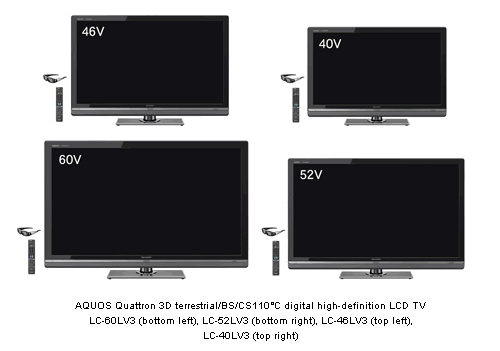
Sharp Corporation will introduce into the Japanese market four models in the new LV Series of 3D-compatible AQUOS Quattron 3D LCD TVs with four-primary-color technology. In addition, Sharp will introduce four new high-image-quality models in the LX Series and two models in the XF Series of AQUOS Quattron LCD TVs. Both 2D and 3D images are vividly reproduced based on four-primary-color technology.
Sharp developed four-primary-color technology based on its proprietary UV2A technology*3 . This technology newly adds Y (yellow) to the three RBG (red, blue, green) primary colors, dramatically improving the ability to faithfully reproduce colors. In particular, it enables both 2D and 3D images to be reproduced with outstanding quality by vividly rendering colors such as brilliant yellow, brassy gold, and emerald green, which are difficult to reproduce using the three conventional primary colors. Further, a significant improvement in light utilization efficiency yielded a reduction in power consumption by approximately 10% compared to previous models with UV2A technology*4.
The 3D-compatible AQUOS Quattron 3D LV Series not only achieved vivid color image rendering, but also increased light utilization efficiency, providing a brightness approximately 1.8 times greater*5 than three-primary-color LCD panels, enabling users to enjoy impressive 3D images. Further, the combination of FRED*6 technology—Sharp’s proprietary high-speed LCD drive technology—and Scanning LED Backlight technology*7 that reduces image lag enables 3D images to be reproduced with an exceptionally realistic sense of depth and with extremely low crosstalk.
The AQUOS Quattron LX Series also features the ability to render rich colors, and these models deliver outstanding image and audio quality for 2D pictures.
The AQUOS Quattron XF Series features an edge-lit LED backlight system to deliver outstanding image quality in a stylish full-flat slim design (only 3.9 cm thick*8).
Sharp will gradually shift to making all of its LCD TVs AQUOS Quattron models. These models will be introduced around the globe and lead the way into a new era of color video.
| Product name |
Terrestrial/BS/CS110° Digital High-Definition LCD TV |
| Nickname |
 |
| Series name |
LV Series |
LX Series |
XF Series |
| Model name |
LC-60LV3
LC-52LV3
LC-46LV3
LC-40LV3 |
LC-60LX3
LC-52LX3
LC-46LX3
LC-40LX3 |
LC-52XF3
LC-46XF3 |
| Dot count (H x V) |
Full high-definition (1,920 x 1,080) |
| Suggested retail price |
Open |
| Date of introduction in Japan |
July 30, 2010 |
July 20, 2010 |
July 1, 2010 |
| Initial monthly production |
15,000 units
(total for series) |
35,000 units
(total for series) |
10,000 units
(total for series) |
| *1 |
Quattron is a combination of the word “quattro” meaning “four" in Italian, and the word “electron” in English. The use of four primary colors is a concept designed for LCDs, and differs from the conventional three-primary-color concept of light and color. |
| *2 |
Double vision in which the images for the right and left eyes overlap in a 3D display that uses separate images for the left eye and right eye to create the perception of a three-dimensional stereoscopic image. |
| *3 |
Abbreviation of Ultraviolet induced multi-domain Vertical Alignment. Photo-alignment technology that can precisely control the alignment of liquid crystal molecules using a manufacturing method based on UV light exposure. |
| *4 |
Annual power consumption (for same size screens) of the LX3 Series compared to the LX1 Series (introduced in November 2009). |
| *5 |
Screen brightness when displaying 3D images compared to Sharp’s previous technology (three-primary-color Advanced Super View LCD without FRED technology). |
| *6 |
Abbreviation of “Frame Rate Enhanced Driving.” LCD signal processing technology for 3D television. |
| *7 |
Technology to control crosstalk generation based on switching the backlight on and off at high speed, and dividing the LCD panel into a number of regions where the brightness of the backlight is independently controllable. |
| *8 |
Thinnest part of the display, excluding protruding parts. |
| *9 |
Abbreviation of “Around Speaker System.” Audio technology in which speakers are arranged around the screen. |
| *10 |
Featured in 60V/52V/46V-inch models (40V-inch models use a 7-speaker system). |
| *11 |
Supported in the LV3 and LX3 Series. |
Major Features
1. Four-primary-color technology faithfully renders colors to provide vivid, high-quality images
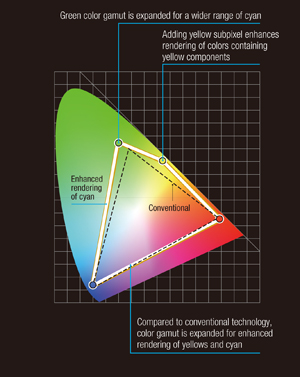
1) Four-primary-color technology faithfully reproduces colors
Sharp’s four-primary-color technology utilizes four primary colors, adding a Y (yellow) subpixel to the three conventional subpixels of R (red), G (green), and B (blue).
This combination expands the color gamut and enables the display to vividly reproduce colors that have been previously impossible to portray, such as sparkling golds and sunflower yellows. In addition, the ability to render cyan is also enhanced, making it possible to vividly reproduce the sense of transparency of an emerald-green ocean.
|

2) Brighter images thanks to higher light utilization efficiency
 Four-primary-color technology improves light utilization efficiency, making brighter images possible. In addition, the yellow wavelength components contained in the LED backlight, which is the light source for the LCD panel, are used with greater efficiency, keeping brightness high and achieving the industry’s highest energy efficiency*12.
| *12 |
For digital HD LCD TVs with 60V-, 52V-, 46V-, and 40V-inch screen sizes sold in the Japanese market (as of May 31, 2010). Comparison of annual power consumption. Applies to the LC-60LX3, LC-52XF3, LC-46XF3, and LC-40LX3. |
|
3) Full High Plus circuitry renders a smoother high-definition image (LV/LX Series)
In conventional three-primary-color displays, images are displayed through the combination of pixels. But in Sharp’s four-primary-color technology, the Full High Plus engine enables the red, green, blue, and yellow subpixels to be combined at the subpixel level. Smoother, more incredibly detailed HD images can be achieved by combining about 1.3 times*13 more subpixels (approximately 8.29 million subpixels) than possible with a conventional display.
| *13 |
Comparison of the number of subpixels in three-primary-color and four-primary-color systems. |
|
2. Impressive 3D images with screen brightness approximately 1.8 times*5 higher than previous models (LV Series)
 1) High-brightness, high-contrast 3D images with an exceptionally realistic sense of depth
Conventional 3D TVs have had a technical challenge in the screen not being sufficiently bright. Thanks to four-primary-color technology, these models achieve a screen brightness approximately 1.8 times*5 higher than that of three-primary-color panels.
They reproduce bright, clear images even when viewed through special 3D glasses, enabling users to enjoy high-contrast 3D images with an exceptionally realistic sense of depth.
|
2) Bright 3D images thanks to the combination of Sharp UV2A and FRED technologies
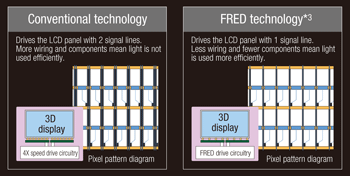
UV2A optical alignment processing technology and four-primary-color technology combine to increase the utilization efficiency of light in the LCD panel, enabling viewers to enjoy bright 3D images.
In addition, in displaying 3D images, conventional displays drive the LCD at high speeds using two signal lines. But these AQUOS models use Sharp’s proprietary FRED technology, which drives the LCD panel at high speed using only one signal line. The result is less wiring and fewer components in the LCD panel, as well as even greater improvements in light utilization efficiency*14.
| *14 |
Comparing light utilization efficiency with Sharp’s previous technology (which does not incorporate FRED technology). |
|
3) High-quality 3D images with extremely low crosstalk
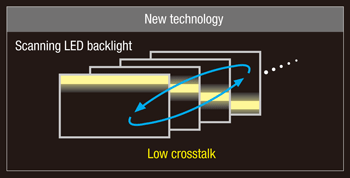
In 3D images, separate images intended for the left eye and right eye are displayed alternately. This system, however, tends to cause crosstalk (undesirable double-contour “ghost” images), in which the images for the left eye and right overlap. AQUOS Quattron 3D models use UV2A technology with superb high-speed response and proprietary FRED technology to display the images for the left and right eyes at double the speed (total 4X speed). This results in extremely low crosstalk.
When displaying 3D images, Scanning LED Backlight technology divides the screen into a number of horizontal bands and turns the LED backlight on and off in those areas at high speed in synchronization with pixel illumination on the screen. This minimizes crosstalk by reducing the visual perception of image lag.
|
4) Compatible with a wide range of 3D video signal formats—from Blu-ray Disc titles to broadcast programming
By connecting to an AQUOS Blu-ray Recorder*15 via an HDMI cable*16, viewers can enjoy Blu-ray Disc titles recorded in 3D with full HD resolution.
These AQUOS models also support 3D video signals input from external sources*17 such as 3D digital broadcast programming and cable TV. Further, these models feature a built-in IrSS receiver*18 which enables users to wirelessly send 3D photographs taken using a digital camera*19 to the TV.
| *15 |
Operation confirmed on the BD-HDW700 and the BD-HDW70 (scheduled for introduction in Japan from July 2010). |
| *16 |
Compatible with 3D video signals that conform to HDMI standards. |
| *17 |
Supports HDMI input and D video (1080i) input (side-by-side/top-and-bottom). |
| *18 |
Featured in the LV3 Series. The LX3 Series supports 2D images only. |
| *19 |
Compatible camera: FinePix REAL 3D W1 from Fuji Film Co., Ltd. (as of May 31, 2010). |
|
5) 2D to 3D conversion
Viewers can comfortably enjoy images created in 2D format as 3D images, including images taken using an HD video camera or digital camera.
Pushing the 3D button on the remote control while viewing 2D images causes the TV to analyze the image stream and display pseudo-3D images*20.
| *20 |
The perceived 3D effect will vary from image to image as well as person to person. |
|
6) 3D Brightness Boost feature makes it simple and easy to change brightness
Pushing the 3D Brightness Boost button on the remote control enables viewers to select the desired screen brightness. With a single touch of the button, users can select a brightness level to match their preferences or the brightness of the room where the TV is being viewed. |
7) Industry’s first 3D glasses equipped with a 3D to 2D conversion function
These models come bundled with a pair of special 3D glasses that are comfortable to wear and feature a 3D to 2D conversion function, an industry first*21.
Simply pushing a button on the glasses while enjoying 3D images enables the individual wearing the glasses to see the images in 2D. This convenient function means that any individual can choose to see the images in either 3D or 2D.
These glasses can be powered*22 via the TV’s USB port by using a commercially available USB cable. They also feature an Auto Power Off function*23.
| *21 |
For active shutter 3D glasses for 3D-compatible digital high-definition TVs; as of May 31, 2010. |
| *22 |
Does not include a function to charge the battery. |
| *23 |
Power for the glasses is automatically turned off when no signal has been received from the 3D transmitter in the TV set for a specified period of time. |
|
| Precautions when viewing 3D stereo images |
| • |
Avoid viewing in 3D if you are ill or not in good health. |
| • |
Discontinue viewing immediately if you feel any change in physical condition while viewing in 3D. |
| • |
The perceived 3D effect will vary from person to person. |
3. ARSS*9 eight-speaker system*10 integrates video and audio, plus Duo Bass*10 low-vibration woofer (LV/LX Series)
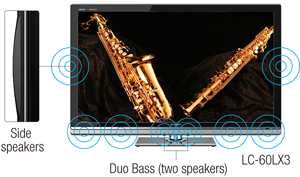
1) ARSS (Around Speaker System) integrates video and audio (LV/LX Series)
These models feature the ARSS 2.1-channel 4-way 8-speaker system. It creates a viewing environment that heightens the sense of unity between the picture and sound.*24
The built-in Digital 1-Bit Amplifier is unaffected by external noise, producing audio with a realistic sense of presence.
| *24 |
The LC-40LV3 and LC-40LX3 models feature a 2.1-channel 4-way 7-speaker ARSS system that does not include the Duo Bass subwoofer system. |
|
2) Duo Bass low-vibration subwoofer reproduces powerful bass sounds (available on LV/LX Series 60V/52V/46V-inch models)
Sharp’s Duo Bass*24 system positions two sub-woofer units facing opposite of each other to decrease excess vibration in the main unit. This system reproduces powerful bass sounds that have been difficult to achieve in conventional flat-panel TVs. |
3) Embedded  audio chipset yields sound with depth and realism (LV Series) audio chipset yields sound with depth and realism (LV Series)
Spacious Sound 3D technology, based on the high-performance AudioEngine™ audio chipset*25 specially tuned for the AQUOS, is a sound field generation technology that reproduces in ordinary homes the acoustical properties of movie theaters and concert halls. It reproduces sound with a spatial component that is ideally suited for 3D images.
| *25 |
AudioEngine is a trademark of Yamaha Corporation. |
|
|

4. Stylish models feature thin and seamless full-flat design just 3.9 cm thick*8 (XF Series)
These models feature an edge-lit LED backlight system to achieve a slim profile only 3.9 cm thick. In addition, the thin and seamless full-flat design provides an uninterrupted transition between the screen and the frame, creating an elegant form while maintaining a subtle simplicity of design.
|
5. Expanded range of applications, including Familink connection to mobile phones, USB hard drive recording*11, and support for wireless LAN adaptors*11
1) Supports recording programs to an external USB hard drive (LV/LX Series)
By connecting a commercially available external USB hard drive*26, users can record and play back digital broadcast programs simply and easily using the TV remote control.
In addition, these models also feature a Frequently Recorded function*27 in which the TV learns the programs or the types of programs most often viewed and automatically saves them on the USB hard drive. Further, in the 3D-compatible LV Series, the Frequently Recorded function can search on the keyword “3D” and give priority to programs that it finds.
| *26 |
Visit the Sharp website to learn the latest information of operation-confirmed hard drive units.
http://www.sharp.co.jp/support/aquos/index.html |
| *27 |
This function records by overwriting (recording capacity is selectable) programs for the periods of time (up to four hours at a time) set by the TV. |
|
2) Support for wireless USB LAN adaptors (LV/LX Series)
By connecting a commercially available wireless USB LAN adaptor*26 to the USB port built into the main unit, users can access the Internet via a wireless LAN router in the home or enjoy a variety of entertainment media on a home network (DLNA compliant).
|
3) Compatible with AQUOS Familink II that provides an expanded feature set and a wider range of supported applications via HDMI cable connection to peripheral equipment
The control panel of peripheral devices such as Sharp’s Blu-ray Disc recorders can be displayed on the screen, and a wide range of linked operations can be performed while viewing the screen. In addition, these models support the Audio Return Channel (ARC) function*28 under the HDMI standard, as well as HDMI Content Type Synchronization. Further, this feature offers a broad array of viewing modes, including displaying photos and video taken with a mobile phone*29 on the wide screen of the TV.
| *28 |
Operation confirmed on AQUOS Audio models AN-AR630, AN-AR530, and AN-AR430 (scheduled to be introduced in Japan from July 2010). |
| *29 |
Operation confirmed on the docomo PRIME Series SH-07B and the AQUOS SHOT SoftBank 945SH. |
|
4) Compatible with home networks to enable viewing programs recorded on an AQUOS Blu-ray Recorder located in another room
By connecting these models to a home network, users can enjoy playing back programs recorded on the hard drive of an AQUOS Blu-ray Recorder*15 located in another room, or play back video, audio, and photographs*30 stored on DLNA-compliant devices*26 connected to the network.
| *30 |
Video, still image, and audio data protected by DLNA/DTCP-IP.
DLNA stands for Digital Living Network Alliance.
DTCP-IP stands for Digital Transmission Content Protection over Internet Protocol. |
|
5) Continuously expanding availability of Internet services—from helpful lifestyle information to HDTV programming
Users can use the TV remote control to simply and easily access high-definition video content available on the Web thanks to proprietary technology (Ex System technology) that provides comfortable, high-speed access to Internet services.
In addition to dedicated AQUOS services such as AQUOS.jp, Yahoo! JAPAN for AQUOS*31 (including video channels), and DoTV Digital Magazine*32, these models also support the acTVila (Full Video)*33 video-on-demand service portal. Users can also watch Hikari TV*34 without a special tuner. And users can also access newspaper services*35.
Further, these models also feature an AQUOS Information function that can display informative notices from connected mobile phones*29 and from Internet services such as weather information*36 on the screen being viewed.
| *31 |
Provided by Yahoo Japan, Inc. |
| *32 |
Provided by NTT Communications Ltd. |
| *33 |
Provided by Actvila Corporation. |
| *34 |
Provided by NTT Plala Inc. Subscription and payment of viewing fee are required. |
| *35 |
Provided by Mainichi Shimbun Co., Ltd. (service beginning on June 1). |
| *36 |
Provided by Weathernews Inc. (service beginning in July). |
|
6. AQUOS High-Picture-Quality Master Engine and Preferred Image Sensor further enhance high image quality
1) AQUOS High-Picture-Quality Master Engine delivers beautiful images
Sharp’s AQUOS High-Picture-Quality Master Engine features a dedicated high-speed image processing chip that brings out the superb display performance of four-primary-color technology.
The combination of the Clear Double Speed function that detects image movement to give a clear picture, and Scanning Double Speed*11 that reduces the visual sensation of image lag by switching the LED backlight on and off at high speeds, enables full-motion video to be clearly rendered. In addition, video performance is further improved by the Smooth Image Quality function that increases image contrast to accurately reproduce subtle color gradations and the Active Conditioner technology that reduces noise. |
2) Preferred Image Sensor automatically adjusts image quality to user preferences, and now includes learning function
These AQUOS models not only adjusts to the room viewing environment and the on-screen content; the Preferred Image Sensor also automatically adjusts*37 image and sound quality to the most desirable settings based on viewers’ personal preferences. User preferences are determined based on answers to a series of simple questions posed at the time the set is initialized.
In addition, a new Preferred Image Settings Learning function*11 has been added. Under this function, the TV learns information from viewed programs, which have been adjusted according to image quality preferences, and this information is reflected in the actions of the Preferred Image Sensor.
| *37 |
Active when the A/V position is set to “Select the Right One”. |
|
Options
1) Special 3D Glasses
These AN-3DG10 3D Glasses*38 are comfortable to wear and attractively designed. Available in three colors.
| *38 |
These glasses have the same specifications as the 3D glasses bundled with the LV Series (one silver-colored pair is included with the LV Series). |
| Product name |
Model |
Suggested retail price (including tax) |
Compatible models |
| 3D Glasses |
AN-3DG10-S (silver) |
Open |
LC-60LV3, LC-52LV3,
LC-46LV3, LC-40LV3 |
| AN-3DG10-R (red) |
| AN-3DG10-A (blue) |
2) Wall-Mount Hardware
A wall-mount bracket assembly is available as a separate option.
| Product name |
Model |
Suggested retail price (including tax) |
Compatible models |
| Wall-mount bracket assembly |
AN-52AG6 |
26,250 yen |
LC-60LV3, LC-60LX3,
LC-52LV3, LC-52LX3,
LC-46LV3, LC-46LX3 |
| AN-52AG7 |
26,250 yen |
LC-52XF3, LC-46XF3
(units must be mounted parallel to wall surface) |
| AN-37AG4 |
18,900 yen |
LC-40LV3, LC-40LX3 |
Specifications
| Product name |
Terrestrial/BS/CS110° Digital High-Definition LCD TV |
| Model name |
LC-60LV3 |
LC-52LV3 |
LC-46LV3 |
LC-40LV3 |
| LCD panel |
Screen size |
60V-inch
(132.9 H x 74.8 V cm; 152.5 cm on the diagonal) |
52V-inch
(115.2 H x 64.8 V cm; 132.2 cm on the diagonal) |
46V-inch
(101.8 H x 57.3 V cm; 116.8 cm on the diagonal) |
40V-inch
(88.6 H x 49.8 V cm; 101.6 cm on the diagonal) |
| Dot count |
1,920 H x 1,080 V pixels |
| TV contrast*39 |
5,000,000:1 |
| Viewing angle |
Vertical: 176°, horizontal 176° |
| Backlight source |
LED (full-array LED backlight) |
| Speakers |
2.0-cm diameter x 2, 1.5 x 2.5 cm x 2, 4 x 10 cm x 2, 5.5-cm diameter x 2 |
2.0-cm diameter x 2, 1.5 x 2.5 cm x 2, 4 x 10 cm x 2, 6.5-cm diameter x 1 |
| Max. audio output (JEITA) |
Total 30 W (7.5 W + 7.5 W + 15W) |
| AC power supply voltage |
100 V AC, 50/60 Hz |
| Power consumption |
240W |
195W |
175W |
155W |
| Standby power consumption |
0.1W |
0.1W |
0.1W |
0.1W |
| Annual power consumption*40 |
220kWh/year |
180kWh/year |
170kWh/year |
144kWh/year |
| Main unit dimensions |
Display section only (W x D x H) |
145.7 x 14.3 x 89.8 cm |
125.7 x 14.0 x 77.9 cm |
112.1 x 14.0 x 70.3 cm |
98.5 x 13.1 x 62.8 cm |
With table stand
(W x D x H) |
145.7 x 34.6 x **195.195.5 cm |
125.7 x 28.8 x 83.2 cm |
112.1 x 26.0 x 75.6 cm |
98.5 x 24.0 x 67.9 cm |
| Main unit weights |
Display section only |
Approx. 38.0 kg |
Approx. 25.5 kg |
Approx. 21.5 kg |
Approx. 15.5 kg |
| With table stand |
Approx. 47.5 kg |
Approx. 31.0 kg |
Approx. 26.0 kg |
Approx. 19.0 kg |
| TV reception channels |
VHF channels 1 to 12, UHF channels 13 to 62, cable TV channels 13 to 63, digital BS channels 001 to 999, digital CS110° channels 000 to 999,
digital terrestrial channels (excluding One-Seg) 011 to 528 (with cable TV pass-thru) |
| Input/output jacks |
HDMI input (3 sets)*41, D5 video input (2 sets), S2 video input, video input (3 sets), analog RGB input (with audio input jack), monitor output (doubles as video input and recording output jack), headphone output, digital audio output (optical), B-CAS card slot, VHF/UHF antenna input, BS/CS110° antenna input, USB (2 ports), LAN (10Base-T/100Base-TX),
controller (RS 232C), AC power input |
| Accessories |
Table stand (pre-assembled on LC-60LV3; ready-to-assemble on LC-52/46/40LV3), wireless remote control, 3D glasses, AAA dry cell battery (alkali), power cord, B-CAS card, tipover-prevention hardware,
operation manual, easy user’s guide, warranty card |
| **1 |
Revised date: July 9, 2010
|
| *39 |
The maximum contrast level a TV set is capable of achieving (the ratio of maximum screen brightness for an all-white signal to the minimum screen brightness with an all-black signal; AV position set to “Dynamic”) |
| *40 |
Measured according to Japan’s Energy Saving Act based on average household TV viewing time (4.5 hours/day). AV position set to “Standard.” |
| *41 |
Supports 480i, 480p, 1080i, 720p, and 1080p. |
| Product name |
Terrestrial/BS/CS110° Digital High-Definition LCD TV |
| Model name |
LC-60LX3 |
LC-52LX3 |
LC-46LX3 |
LC-40LX3 |
| LCD panel |
Screen size |
60V-inch
(132.9 H x 74.8 V cm; 152.5 cm on the diagonal) |
52V-inch
(115.2 H x 64.8 V cm; 132.2 cm on the diagonal) |
46V-inch
(101.8 H x 57.3 V cm; 116.8 cm on the diagonal) |
40V-inch
(88.6 H x 49.8 V cm; 101.6 cm on the diagonal) |
| Dot count |
1,920 H x 1,080 V pixels |
| TV contrast*39 |
5,000,000:1 |
| Viewing angle |
Vertical: 176°, horizontal 176° |
| Backlight source |
LED (full-array LED backlight) |
| Speakers |
2.0-cm diameter x 2, 1.5 x 2.5 cm x 2, 4 x 10 cm x 2, 5.5-cm diameter x 2 |
2.0-cm diameter x 2, 1.5 x 2.5 cm x 2, 4 x 10 cm x 2, 6.5-cm diameter x 1 |
| Max. audio output (JEITA) |
Total 30 W (7.5 W + 7.5 W + 15W) |
| AC power supply voltage |
100 V AC, 50/60 Hz |
| Power consumption |
Approx. 222 W |
Approx. 170 W |
Approx. 155 W |
Approx. 137 W |
| Standby power consumption |
0.1 W |
0.1 W |
0.1 W |
0.1 W |
| Annual power consumption*40 |
178 kWh/year |
150 kWh/year |
135 kWh/year |
117 kWh/year |
| Main unit dimensions |
Display section only (W x D x H) |
145.7 x 14.3 x 89.8 cm |
125.7 x 14.0 x 77.9 cm |
112.1 x 14.0 x 70.3 cm |
98.5 x 13.1 x 62.8 cm |
With table stand
(W x D x H) |
145.7 x 34.6 x **195.195.5 cm |
125.7 x 28.8 x 83.2 cm |
112.1 x 26.0 x 75.6 cm |
98.5 x 24.0 x 67.9 cm |
| Main unit weights |
Display section only |
Approx. 37.5 kg |
Approx. 25.0 kg |
Approx. 21.0 kg |
Approx. 15.0 kg |
| With table stand |
Approx. 47.0 kg |
Approx. 30.5 kg |
Approx. 25.5 kg |
Approx. 18.5 kg |
| TV reception channels |
VHF channels 1 to 12, UHF channels 13 to 62, cable TV channels 13 to 63, digital BS channels 001 to 999, digital CS110° channels 000 to 999,
digital terrestrial channels (excluding One-Seg) 011 to 528 (with cable TV pass-thru) |
| Input/output jacks |
HDMI input (3 sets)*41, D5 video input (2 sets), S2 video input, video input (3 sets), analog RGB input (with audio input jack), monitor output (doubles as video input and recording output jack), headphone output, digital audio output (optical), B-CAS card slot, VHF/UHF antenna input, BS/CS110° antenna input, USB, LAN (10Base-T/100Base-TX), controller (RS 232C),
AC power input |
| Accessories |
Table stand (pre-assembled on LC-60LX3; ready-to-assemble on LC-52/46/40LX3), wireless remote control, AAA dry cell battery (alkali), power cord, B-CAS card, tipover-prevention hardware, operation manual,
easy user’s guide, warranty card |
| **1 |
Revised date: July 9, 2010
|
| Product name |
Terrestrial/BS/CS110° Digital High-Definition LCD TV |
| Model name |
LC-52XF3 |
LC-46XF3 |
| LCD panel |
Screen size |
52V-inch
(115.2 H x 64.8 V cm; 132.2 cm on the diagonal) |
46V-inch
(101.8 H x 57.3 V cm; 116.8 cm on the diagonal) |
| Dot count |
1,920 H x 1,080 V pixels |
| TV contrast*39 |
5,000,000:1 |
| Viewing angle |
Vertical: 176°, horizontal 176° |
| Backlight source |
LED (edge-lit) |
| Speakers |
1.5 x 9.4 cm x 4, 10-cm diameter x 1 |
| Max. audio output (JEITA) |
Total 30 W (7.5 W + 7.5 W + 15W) |
| AC power supply voltage |
100 V AC, 50/60 Hz |
| Power consumption |
Approx. 160 W |
Approx. 145 W |
| Standby power consumption |
0.2 W |
0.2 W |
| Annual power consumption*40 |
145 kWh/year |
133 kWh/year |
| Main unit dimensions |
Display section only (W x D x H) |
126.0 x 4.5 x 81.2 cm |
112.7 x 4.5 x 73.4 cm |
With table stand
(W x D x H) |
126.0 x 34.0 x 86.2 cm |
112.7 x 34.0 x 78.5 cm |
| Main unit weights |
Display section only |
Approx. 30.5 kg |
Approx. 24.5 kg |
| With table stand |
Approx. 36.0 kg |
Approx. 30.0 kg |
| TV reception channels |
VHF channels 1 to 12, UHF channels 13 to 62, cable TV channels 13 to 63, digital BS channels 001 to 999, digital CS110° channels 000 to 999,
digital terrestrial channels (excluding One-Seg) 011 to 528 (with cable TV pass-thru) |
| Input/output jacks |
HDMI input (3 sets)*41, D5 video input, video input, analog RGB input (with audio input jack), headphone output, digital audio output (optical), B-CAS card slot, VHF/UHF antenna input, BS/CS110° antenna input, USB, LAN (10Base-T/100Base-TX), controller (RS 232C), AC power input |
| Accessories |
Table stand (ready-to-assemble), wireless remote control, AAA dry cell battery (alkali), power cord, video/audio relay cord, B-CAS card, tipover-prevention hardware, operation manual, easy user’s guide, warranty card |
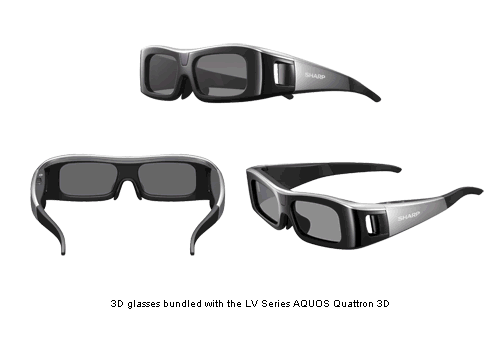 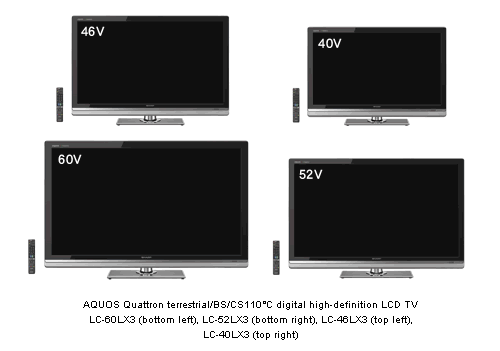  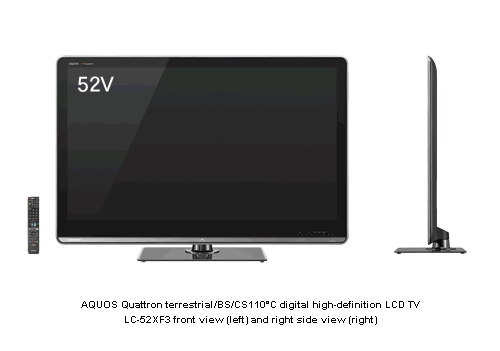
| The following information is true and accurate at the time of publication. Manufacture, sale, price and specifications of products may be subject to change. |
|